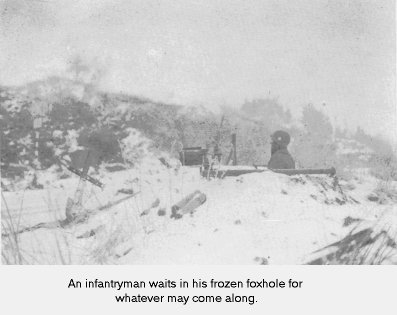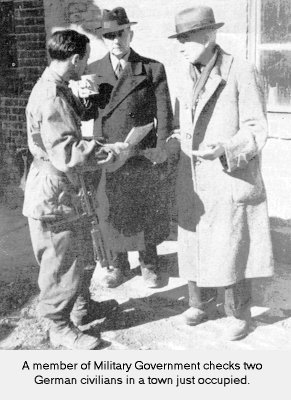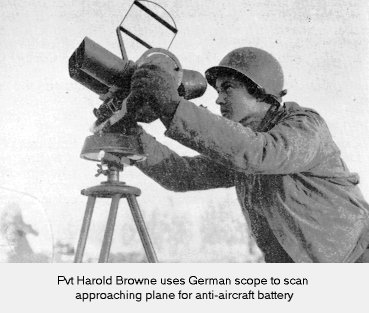Ardennes Campaign |
|
Germany Campaign |
|
|
Chapter V |
Ardennes Campaign |
|
Germany Campaign |
|
|
Chapter V |

The Division mission was to patrol to and across the OUR River, prevent enemy infiltration across the OUR, prepare plans to cross the river, and be prepared to attack northeast or east to the KYLL River.
III Corps believed that the bulk of enemy strategic reserves east of the OUR had been withdrawn and also that local forces had been drawn to the north by the VIII Corps attack. It appeared that the SIEGFRIED LINE was inadequately manned on the Corps front. Oral instructions were received from the III Corps Commander to make a reconnaissance in force across the OUR River during the night 6 7 February, and if a bridgehead could be maintained, establish one for future operations to the east.
Four bridgesites for the OUR crossing had been chosen by infantry engineer
reconnaissance parties.
In an exceptionally well conducted operation, the difficult stream was crossed at two places, above and below the KALBORN-DAHNEN road by two reinforced companies, followed by other companies prepared to cross and,exploit any ground gained. During the day 18 assault teams consisting- of engineers equipped with flame throwers to reduce pillboxes were formed.
Footbridges were constructed in the north and the battalion that had crossed moved to the south and east to secure the east bank of the Bailey bridge site, which was to go in at the approach leading east from KALBORN. Fanning out, the foot-troops enlarged the bridgehead to a depth of one mile on a two mile front. On the 8th of February the Division continued to expand and consolidate its bridgehead on the east side of the OUR against increasing resistance. Rising waters hampered bridging operations, as the river had increased 15 feet in width during the last 24 hours, but three foot bridges, two pontoon, and one suspension bridge had been established. The suspension bridge was short-lived, however, for enemy mortar fire knocked it out shortly after it had been placed in operation. Work was under way on the Bailey bridge.
Rotation of the tiring troops on the east shore of the OUR River was
made 10 February, when Combat Command B sent a force into the bridgehead
relieving Reserve Command's men. On 11 February the Division passed
to control of VIII Corps and completed relieving the 17th Airborne Division
in its zone, taking over the small bridgehead the Airborne Division had
effected 1200 yards north of DASBURG.
Assaulting troops found their greatest obstacles to be mines, wire and
booby traps and the physical difficulty of breaking into pillboxes.
Enemy fire was comparatively light.
The command continued its advance, fanning to the left and right cleaning
out the rest of the fortifications from DAHNEN to the northern boundary
of the Division's zone. The defense put up by the Germans was of
low caliber. Enemy fire, both artillery and mortar, as well as small
arms, was comparatively light.

Initial gains against the SIEGFRIED LINE were approximately two miles
in depth and two miles in width. A total of 40 pillboxes was taken
with a loss of only two of our troops killed. In the early morning
of 21 February, Combat Command B' s tank-riding infantry raced to the south
and east through meager defenses to capture four German towns: DAHNEN,
DALEIDEN, DASBURG and REIPEINGEN. By nightfall the northern flank
had been secured with a force waiting to link up with the 11th Armored
Division, which was attacking to the Division's north.
Combat Command A came into play the following day, when combat engineers mounted on armor quickly dashed south on the road leading from DASBURG to capture PREISCHEID and AFFLER, bypassing the pillboxes facing the OUR River. This force rode into UBER EISENBACH late that afternoon, tying in with the southern elements of the command. A line of engineers and tanks was now strung to the rear of the SIEGFRIED fortifications cutting off any possible enemy withdrawal.
In the northern zone the attack continued. An effort was made to delay
the armored force. The enemy sent some tanks against the attack in the
hills south of the DASBURG-DALEIDEN road on 23 February. Dismounting,
the foot troops made short work of the counterattack by destroying two
German Mark IV tanks and driving the others off. Operations by dark
showed the Division had successfully secured a line from IRRHAUSEN on the
north boundary southwest to PREISCHEID and south to the junction of the
OUR and IRSEN Rivers. At dawn the next morning a special mounted
task force was released by Combat Command B to drive southeast across the
6th Cavalry front which was on the Division's southern flank, and cut off
the fleeing enemy's escape route. Added to their mission, this mounted
force was to contact the northern flank of the XII Corps and capture NEUERBERG.
By 1330A 24 February, the task force radioed Combat Command B telling the
command the mission was accomplished and that it was withdrawing to the
division zone.
 THE PAYOFF
THE PAYOFFAfter relieving the 90th Infantry Division west of the PRUM River, the Division resumed the attack to the east on 25th February. Under darkness, elemental of Combat Command A forced the PRUM River on 27 February in the vicinity of HEILHAUSEN to seize the high ground to the southeast against light enemy resistance. In the early morning of the same day, a force from Combat Command B breached the river and held positions to the north.
The bridgeheads were enlarged on the 28th February, with the capturing of DACKSCHEID, EILSCHEID, MERLSCHEID, LIERFELDI and LUNEBACH.
A coordinated attack was launched 2 March to secure a bridgehead across the NIMS River ancl continue east. Combat Command B on the left with three forces, and Combat Command A on the Division right flank advanced steadily meeting little opposition. By 3 March, three bridges spanning the NIMS were taken intact and by late afternoon positions on the high ground east of the river were secured and outposted.
Elements of the 90th Infantry Division began relieving the forward troops
of the 6th Armored by night-fall of the 3rd of March, and within 24 hours
the entire division was out of contact with the enemy -- the first time
since its commitment on the CHERBOURG PENINSULA, 221 consecutive fighting
days. From COUTANCES to AVRANCHES (spearheading the breakthrough)
and the 230-mile race alone to BREST; at LORIENT; from the NANCY bridgehead
to the SIEGFRIED defenses of SAAR BRUCKEN; and from BASTOGNE through the
SIEGFRIED LINE to SCHONECKEN on the NIMS River, the 6th Armored had continuously
faced the enemy.
Ardennes Campaign |
|
Germany Campaign |
![]() Return
to 6th Armored home page.
Return
to 6th Armored home page.
NOTE: Remove question mark from email address below when sending email.
Page maintained by Bruce
Frederick
Last update:
May 16, 1998 ![]()